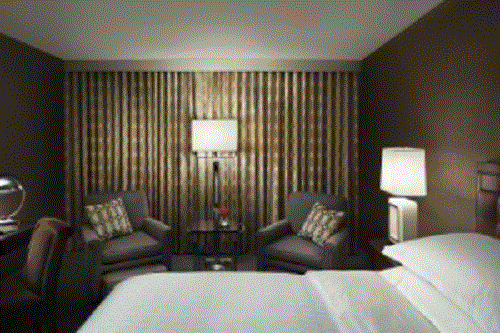WHITE PLAINS, NEW YORK The two largest brands in the Starwood Hotels & Resorts Worldwide portfolio are getting a makeover.
Starwood is touting the redesigned guestrooms for its Westin and Sheraton brands as “highly functional, globally relevant and designed to reflect each brand’s distinct personality.”
Inspired by natural elements and featuring neutral color palettes, natural woods and stone, the new Westin guestrooms play off the brand’s philosophy of preserving wellness on the road while evoking a sense of balance. For the new Sheraton guestrooms, the design team used the brand’s history as a global industry icon as inspiration, using rich color palettes with pops of accent colors and modern interpretations of classic herringbone, basket-weave and geometric patterns.
The new guestroom schemes, from furniture to textiles, were custom-created by Starwood’s in-house brand design team led by Erin Hoover, vice president of design. With a background in fashion, fine art and industrial design, the team applied findings from extensive in-room behavior research that indicated guests’ desire for a greater level of stylish functionality.
The new room designs will be featured in new hotels and renovation projects globally across both brands. The first Westin hotels to showcase the new room designs will be The Westin Phoenix, which is scheduled to open February 2011, and The Westin Gaslamp Quarter in San Diego, which will complete a full renovation including rooms in early 2011. The first Sheraton hotels to feature the new guestroom design are Sheraton Red Deer, Alberta, and Sheraton Syracuse University Hotel & Conference Center, New York, which are scheduled to be renovated in early 2011.
Details of the new design

Both new room schemes blend great design with intuitive functionality to provide a solution for many travelers’ pet peeves. No more crawling on hands and knees to find a free outlet; gone are the luggage racks of yesteryear; and there is somewhere to put the roomservice tray.
Custom Westin-designed accent tables fold out to fit a roomservice tray or laptop, and fold closed to occupy a smaller space. With a quick flip the multiuse table can serve as a working area for an impromptu laptop session or transform into an intimate table for in-room dining. The expanded Westin closet includes shelves and the minibar, freeing valuable room space and reducing clutter. Upholstered benches double as luggage racks and are stored under the television console. New Westin guestrooms incorporate strategically-placed, adjustable LED reading lights in the headboard.
Custom Sheraton-designed bedside tables feature built-in outlets that face beds, facilitating easy computer and electronics charging use. and oversized signature Sheraton armchairs include ottomans stored beneath seats, creating additional living area space. Sheraton rooms feature an LED nightlight.
Westin’s two new guestroom designs—Westin Classic and Westin Modern—stay true to the brand’s commitment to wellbeing by incorporating subtle design cues tied to the elements of nature with a hint of modernism. The new rooms also represent a 60% growth in sustainability, using eco-friendly materials such as energy-conserving LED and CFL lights, water-conserving low-flow plumbing and recyclable carpet pads, low VOC finishes for casegoods and GreenGuard-certified solar shades. With new-builds comprising 95% of the hotels in Westin’s pipeline, the new designs will play a pivotal role in reinforcing the brand’s identity and wellness strategy.
Westin Classic takes inspiration from forms of Art Deco. The visual vocabulary is grounded in classicism but modernized through the selection of furniture pieces and color palette. Materials reference those found in natural settings, including open-grained walnut-stained a dark chocolate brown with a satin finish and soft tones inspired by the outdoors.
Westin Modern has a contemporary, timeless sensibility without being trendy; concise, linear qualities give the modern scheme an architectural feel. The guestroom is softened with organic textures that have subtle patterns and sustainable materials that are neutral in color.
For the Sheraton brand’s two new designs—Sheraton Revival and Sheraton Heritage—the design team incorporated current fashion and lifestyle trends that highlight heritage and pay homage to the brand’s 75-year history. The result is a classic design concept that is approachable and refined with a modern twist. The new Sheraton guestrooms also feature eco-friendly materials including CFL lighting features and low-flow plumbing. Gallery-framed artwork is thoughtfully arranged in vignettes to convey a residential feel. The new Sheraton interiors are designed to be warm and welcoming with a decidedly modern look and feel.
Sheraton Revival is inspired by the Regency Revival of the early 20th century. Furniture profiles have curved corners and textiles have curved interlocking patterns, all of which are complemented by the design’s rich color palette of camel and tan with accents of plum and black. Sheraton Heritage is inspired by the historic Regency period of the late 18th and early 19th century, when Thomas Sheraton created timeless furniture designs that are still used in interiors today. Notched arch details are featured in most furnishings and complemented by geometric patterns in the room’s textiles and carpets.
